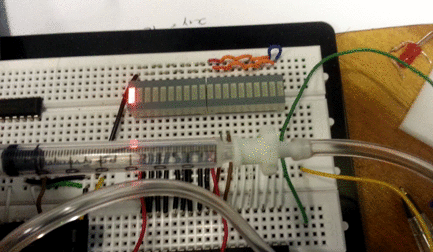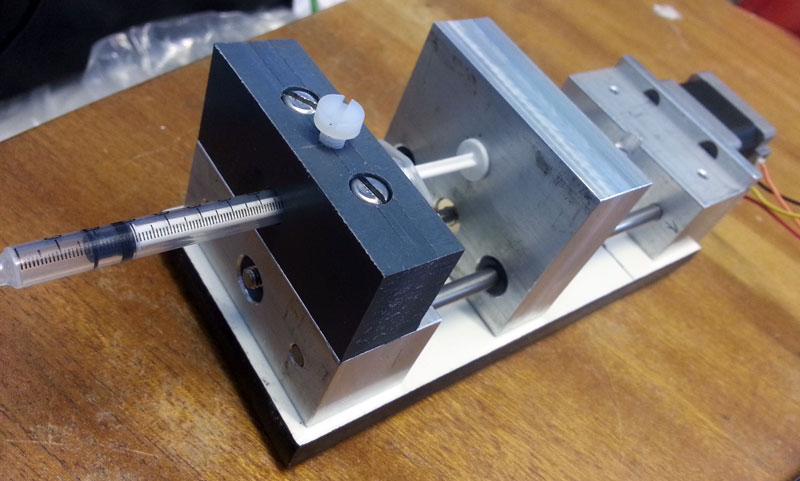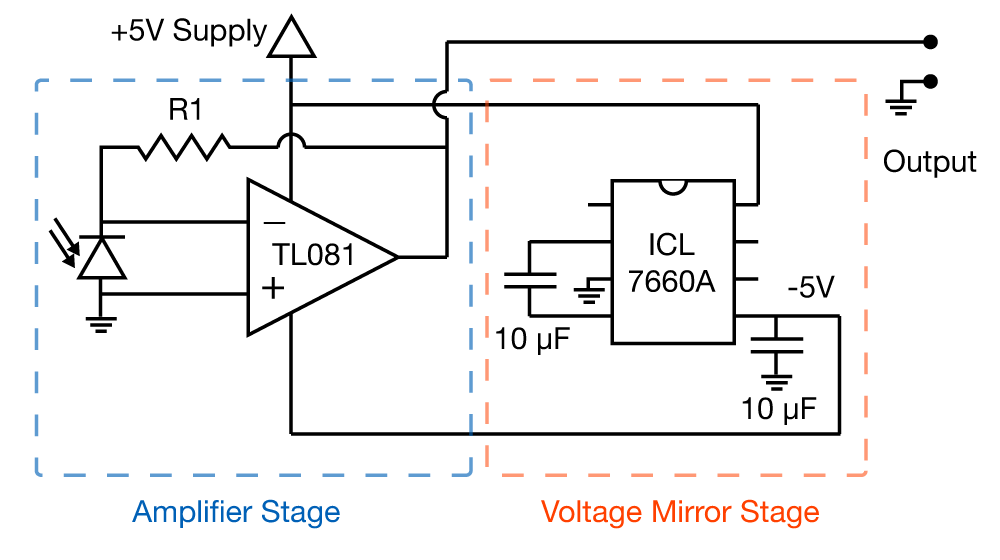 Sometimes you just need to get a notion about whether a signal is big, little or non-existent, rather than its exact value to 4 decimal places. In my case, I wanted a manometer, so I could tell how much pressure the students were apply by mouth when learning to patch cells. I could also imagine someone wanting to measure the DC value of a voltage that they were applying a digital high pass filter to, just to make sure it didn’t go out of the range of the DAQ. I’ve seen people use cheap multimeters for such task, In this case, I offer a solution, that is perhaps more modular, and certainly cheaper.
Sometimes you just need to get a notion about whether a signal is big, little or non-existent, rather than its exact value to 4 decimal places. In my case, I wanted a manometer, so I could tell how much pressure the students were apply by mouth when learning to patch cells. I could also imagine someone wanting to measure the DC value of a voltage that they were applying a digital high pass filter to, just to make sure it didn’t go out of the range of the DAQ. I’ve seen people use cheap multimeters for such task, In this case, I offer a solution, that is perhaps more modular, and certainly cheaper.
A cheap LoFi speaker – Impedance II
I needed to make a little speaker. The real reason? Because of a retro gaming session at work. However, there have been several times that I’ve needed a small cheap speaker that was suitable for delivering simple stimuli. I thought I would post a schematic and take this opportunity to give you an example of how Matlab can make impedance calculations easier, something I’ve talked a little about before.
Trying to make the worlds cheapest syringe pump/linear drive
99% of things you buy from scientific suppliers are violently overpriced. Peristaltic pumps for $2000 that only contain $50 worth of equipment. Homeothermic blankets should only cost about three fifty. But the one that has always annoyed me are syringe drivers. These are nothing more than a stepper motor, a lead screw and a bit of electronics. The budget ones tend to start at around $300, and they go up to ten times that. I’m not standing for that, and neither should you. So I wanted to make one myself.
Impedance: A beginner’s guide -or- how I learned to stop worrying and let Matlab do the work.
Impedance is a concept that some people say they understand, but deep in their heart of hearts they know they don’t. I’m going to try and help you get a more helpful conceptual understanding of it. But to try and entice you into learning about it, I’m going to pose you a question: where does a sine wave go, when it’s amplitude is zero?
Continue reading
Detecting Light: Simple Photodiode Amplifier
Light is great stuff. It provides energy to the ecosystem stuff, preventing earth from being a blue and grey desolate rock, but more importantly, it is really helpful in the lab. I use it mainly in a beam break manner, so I can tell whether something is in a region of space, without touching it. But it can also be used to detect distance, movement, temperature and pretty much anything else you can think of, so long as you can detect the light accurately enough. And this is exactly what I’m about to teach you: how to detect light, amplify it, and make it work for you. The following circuit isn’t designed for ulta-high precision, but it can be made with less than 10 components, and only requires one design decision.
Extracting raw data from figures
Because I’m a cynical bastard, I regularly try to figure out what the real content of a published waveform is. For me, it’s usually someones EEG data that supposedly has some FFT peak that I can’t really believe. So instead of pouring over waveforms with Photoshop (read: Microsoft Paint) to figure out the data that’s in the an image, some time agoe ago I wrote a program in python to allow you to automatically get the numbers.
So I finally translated it to JavaScript, so all of you can benefit from it (and also I can use it at SfN).
Continue reading
Shouting Into the Void: Interacting with PubMed part II
So you’ve just been accepted for publication. At this point, after months of extra experiments and back and forths with reviewers, you’re probably well and truly sick of your paper. However, the months roll by you look at the paper again, you note a cute bit of data analysis here, nice turn of phrase there, and with a gleam in your eye you look to see how many citations you’ve gotten. And unless you’re very lucky, that number might well be still in single digits. 12 months of work, and less than 10 people have ever cited your work. Maybe you feel like it was all for nothing. Well I’m here to make you feel better, because your work was much more important than that. Continue reading
Interacting with PubMed. Part I
As a scientist, your life’s work is your publication list. I like to be intimate with mine. Sometimes I just stare at it. I’d buy it a glass of wine if I could. Maybe even caress it softly. Sure, she ain’t much to look at, but she’s mine, and I want to show her off. And if you want a job, you’re going to want to show yours off too. So I’m going to show you how to scrape your publication list from Pubmed with Python. Continue reading
Triggering things…
For my first post I’m going to gift to you knowledge of what may be the single most useful circuit you will ever see. I have made over a dozen of these for various people, and its uses are never ending. Do not be scared if you’ve never made a circuit before. This is so simple. And you will feel like an absolute master when you’ve finished it.
I give you, The Triggerer



